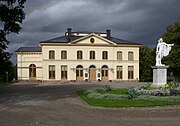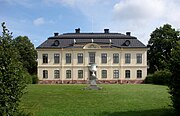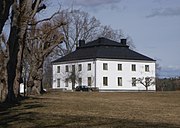Carl Fredrik Adelcrantz
Carl Fredrik Adelcrantz (30 January 1716 – 1 March 1796) was a Swedish architect and civil servant. Adelcrantz's style developed from a rococo influenced by Carl Hårleman, the leading architect in Sweden in the early years of his career, to a classical idiom influenced by the stylistic developments in France in the mid-to-late 18th century. As överintendent, he headed the royal and public building works from 1767 until his retirement in 1795.
Family and childhood
Adelcrantz was born in 1716 in Stockholm and was the son of the architect Göran Josuæ Adelcrantz, who had changed his name from Törnqvist at his ennoblement four years earlier.[2] As a student in Uppsala, Göran Josua Törnqvist had been a member of the student theatre troupe known as Den Swänska Theatren that later performed in the Lejonkulan theatre in Stockholm.[3] He came into the employment of Nicodemus Tessin the Younger in 1697, the year the disastrous fire at the old Castle of Stockholm took place and the planning for the new palace began. Törnqvist had studied architecture before this and may have been discovered by Tessin for his scenographies.[4] Göran Josua Adelcrantz remained in the shadow of the dominant Tessin; his most significant work was the cupola for the Katarina Church in Stockholm.[5]
Through his marriage in 1711 to the young widow Anna Maria Köhnmann, daughter of a wealthy businessman, Törnqvist's finances improved considerably. Among other things, he became the possessor of the manor of Signhildsberg near Sigtuna.[6] The next year Charles XII ennobled him, on the recommendation of his patron Tessin.[7] Born in Stockholm, Carl Fredrik was the third child of the marriage.[8]
Studies and early career
The elder Adelcrantz did not intend for Carl Fredrik to follow in his professional footsteps; he had, for political reasons, lost his positions as court architect and city architect of Stockholm in 1727, and, under the circumstances, he regarded architecture as too insecure a profession for his son.[9] After a short time of study in Uppsala, Carl Fredrik began his career as a low-level civil servant in the Kammarrevisionen court (the future Kammarrätten, the Administrative Court of Appeals in Stockholm).[10]
Göran Josua Adelcrantz did not attempt to suppress the artistic inclination of his son. Carl Fredrik took lessons in drawing and assisted his father in some tasks; he designed an altar for the Katarina Church that was under reconstruction after its first fire, and a tower for the Finnish Church that never came to execution.[11] Half a year after his father's death in 1739, Carl Fredrik Adelcrantz left his employment in Kammarrevisionen, and on 11 August 1739 he left Stockholm for France and Italy. Although his notes from the journey have been lost, it is known that he spent two years in Paris and several months in Rome.[12] In December 1741, while he was still in Rome, Adelcrantz was given a position within the palace construction project.[13] Count Carl Gustaf Tessin, to whom he had turned for a recommendation, had still to become convinced that his talent equaled that of his father, but Carl Hårleman made sure that Adelcrantz would get the appointment.[14] In late summer 1743, he started on his return journey to Sweden, arriving in Stockholm in November.[15]
Courtier and architect
Beside his work in the palace construction, he was also given the court title of
The office of överintendent had been created for
At the end of 1753, Adelcrantz was again given a foreign mission, now to Paris. In accordance with his instructions, he sent home a large number of models and engravings to be used for interior details in the latest fashion. He also contracted Pierre Hubert L'Archevêque as a successor to J. P. Bouchardon, who had died in December 1753. In Paris, Adelcrantz sat for the portrait by Alexander Roslin that he later bequested to the Swedish Academy of Arts. Adelcrantz and Roslin may already have met in Stockholm before the latter left for the continent, or in Italy a few years before, but the stay in Paris appears to have been the beginning of a long friendship and an extensive but now-lost correspondence.[20] The diary that he is known to have kept during his journey was mentioned as sold at auction in 1831, but also appears to be lost.[21] After his return, he worked on the furnishing of the Palace which was finished in November, when he was appointed a Knight of the Order of the Polar Star. The same year also saw his election as a member of the Royal Swedish Academy of Sciences.[22]
Överintendent
After Cronstedt left the position of överintendent in 1767, Adelcrantz was appointed his successor. At the time, he had already held the title honoris causa for ten years. With the position came, ex officio, that as president of the
As a consequence of his journey to Italy and France in 1783-84, the King's stylistic ideals changed in a more radical classicist direction. Adelcrantz adapted to the changing architectural fashions, but younger architects whose sensibilities were more in line with the current trends advanced in the favour of the King, and Adelcrantz found himself increasingly sidelined.[25] In 1787, the 72-year-old architect petitioned the King for permission to retire, giving both his failing health and financial difficulties as reasons. The petition was refused by the King; only in 1795 was Adelcrantz given permission to retire as överintendent, leaving the reins to his successor, Carl Fredrik Fredenheim, on 16 February. He had been active civil servant until his last days in office, and his last architectural design was for an altar for the parish church of Stockholms-Näs, made during these same last days, at the age of 80.[26] He retired as president of the academy of Art a few months later, in June 1795.[27] His last days, until he died in Stockholm in March 1796, was plagued by a painful cancer and increasing financial problems.[28]
Adelcrantz's development as an architect
Adelcrantz's earliest influences came from the Baroque architecture that he could study in the pattern books and engravings in his father's library; his first known design, the altar for the church of
Adelcrantz' first commissions of significance were the Ulriksdal Palace Theatre and the residential building in Stockholm that he originally designed for his brother-in-law Gustaf Samuel Ruuth (but would later take over himself), both from 1753, the year of Hårleman's death.
Select designs
-
Sturehov Castle, 1780s
-
Fredrikshov, 1774
-
Gustav III Opera house, 1775
Select buildings
-
Drottningholm theatre
-
Trångsund mansion
Notes
- ^ Alexander Roslin, ed. Magnus Olausson, p. 135
- ^ Fogelmarck 1994, p. 14
- ^ Fogelmarck 1994, p. 9
- ^ Fogelmarck 1994, p. 9
- ^ Fogelmarck 1994, p. 16
- ^ Fogelmarck 1994, p. 14
- ^ Fogelmarck 1994, p. 14
- ^ Fogelmarck 1994, p. 18
- ^ Fogelmarck 1994, p. 18
- ^ Fogelmarck 1994, p. 18
- ^ Fogelmarck 1994, p. 19
- ^ Fogelmarck 1994, p. 22
- ^ Fogelmarck 1994, p. 21
- ^ Fogelmarck 1994, p. 21
- ^ Fogelmarck 1994, p. 22
- ^ Fogelmarck 1957, p. 19
- ^ Fogelmarck 1957, p. 19-31
- ^ Fogelmarck 1957, p. 32
- ^ Fogelmarck 1994, p. 54-55
- ^ Fogelmarck 1957, p. 34: Adelcrantz's nephew, C. F. Sundvall, mentions the correspondence in a letter to A. U. Wertmüller from 1797.
- ^ Fogelmarck 1957, p. 33 & 286, note 47 (the diary is known to have been bought at an auction in 1831 by the architect Axel Nyström).
- ^ Fogelmarck 1957, p. 36
- ^ Fogelmarck 1957, p. 39 f
- ^ Fogelmarck 1957, p. 40-42
- ^ Fogelmarck 1957, p. 42 f
- ^ Fogelmarck 1957, p. 45
- ^ Fogelmarck 1957, p. 45
- ^ Fogelmarck 1957, p. 46
- ^ Fogelmarck 1957, pp. 212-216
- ^ Fogelmarck 1957, p. 00
Bibliography
- Alexander Roslin, ed. Magnus Olausson. Nationalmusei utställningskatalog, 0585-3222; 652. Stockholm: Nationalmuseum, [2007] (ISBN 978-91-7100-771-1.)
- Fogelmarck, Stig: Carl Fredrik Adelcrantz, arkitekt. (Monografier utgivna av Stockholms kommunalförvaltning, 20). Stockholm: Almqvist & Wiksell/Gebers förlag, 1957. (Dissertation, Stockholm University, 1957)
- Fogelmarck, Stig: Carl Fredrik Adelcrantz. Ett gustavianskt konstnärsöde. (Vitterhetsakademiens skriftserie Svenska lärde). Stockholm: Natur & Kultur, 1994.
External links
 Media related to Carl Fredrik Adelcrantz at Wikimedia Commons
Media related to Carl Fredrik Adelcrantz at Wikimedia Commons








